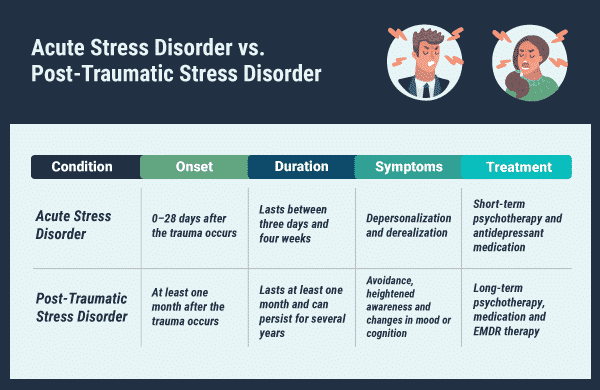Learn about the key differences between acute stress disorder vs. PTSD and discover how to find the appropriate treatment options for seeking help.
Overhalf of Americansexperience at least one traumatic event during their lifetimes. Trauma can trigger lasting effects that impair one’s physical, psychological and emotional well-being. It can also lead to the onset of mental illnesses, includingacute stress disorderandpost-traumatic stress disorder (PTSD).
Learning more about these conditions can help you differentiate between the two diagnoses.Acute stress disorderrefers to the initial traumatic symptoms that arise immediately after a traumatic event.PTSDrefers to the long-term aftermath of trauma. PTSD can follow after ASD, but it can also occur even when ASD does not develop. PTSD can only be diagnosed if symptoms have lasted longer than a month.
Characteristics of Acute Stress Disorder
Acute stress disorder symptoms tend to follow immediately or shortly after a traumatic stressor. The stressor can either be experienced personally or witnessed.
The signs of acute stress disorder typically include:
Treatment Can Be Life Changing. Reach out today.
Whether you are struggling with addiction, mental health or both, our expert team is here to guide you every step of the way. Don’t wait— reach out today to take the first step toward taking control of your life.
- Severe anxiety
- Dissociation(sense of detaching from one’s self)
- Dissociative amnesia(trouble remembering various details from the event)
- Flashback episodes
- Nightmares
- Difficulty sleeping
- Poor concentration
- Hypervigilance
- Avoiding or withdrawing from people, places or experiences that are reminiscent of the trauma
These symptoms cause clinical distress in one’s interpersonal, occupational or academic functioning. The symptoms last anywhere from three days to four weeks, with the initial onset occurring within four weeks of the traumatic event.
Due to the sense of detachment or derealization, individuals with acute stress disorder may find it challenging to maintain their daily routines. They may also lose pleasure in activities and hobbies they once enjoyed.
Symptoms of PTSD
Like acute stress disorder, PTSD also involves direct or indirect exposure to a traumatic event. While PTSD signs and symptoms can vary in severity, they result in some degree of clinical and emotional distress.
Are you or a loved one dealing with a life-altering trauma and are struggling to cope? ContactMental Health Americaat 1-800-273-TALK (8255) to find help today.
In response to the trauma, individuals with PTSD re-experience nightmares, flashbacks or intrusive and unwanted memories of the event. People with PTSD will often avoid people, places or activities that remind them of the event to try to avoid re-experiencing the event.
Individuals also experience negative thoughts, feelings and heightened alertness to danger after the trauma. These symptoms can range include intense feelings of isolation, negative mood, trouble concentrating and risky or destructive behavior. Delayed onset of symptoms can occur, with some people first experiencing signs of PTSD up to six months after the traumatic event occurred.
Related Topics:
Is there a cure for PTSD
PTSD self treatment
How Does Acute Stress Disorder Differ from PTSD?
The primary differences between acute stress disorder and PTSD involve the onset, duration of symptoms, symptoms experienced and treatment options used to address each condition.
- Onset:While acute stress disorder lasts 0–28 days after a trauma occurs, an individual must experience symptoms at least one month after a traumatic event to be diagnosed with PTSD
- Duration of Symptoms:Symptoms of acute stress disorder last between three days and four weeks, while symptoms of PTSD must last for at least a month and may persist for several years
- Symptoms Experienced:Acute stress disorder is typically characterized by dissociative symptoms, while PTSD may involve re-experiencing, avoidance, heightened arousal and marked changes in mood and cognition
- Treatment Options:Short-term psychotherapy and antidepressant medications are most commonly used to address acute stress disorder, while long-term psychotherapy, medication and EMDR therapy can help relieve PTSD symptoms

Similarities Between ASD and PTSD
Both acute stress disorder and PTSD result from experiencing or being exposed to trauma. As a result of the trauma, the individual struggles with a sense of emotional dysregulation, heightened arousal and a tendency to avoid triggering situations, people or events. However, while acute stress disorder can only last up to one month, PTSD can persist for years.
The causes of PTSD mirror those of acute stress disorder. Specific events that may trigger PTSD include:
- Physical violence or attacks
- Sexual assault and rape
- Terrorist attacks
- Exposure to death
- Severe neglect
- Emotional abuse
- Life-threatening medical conditions
- Severe injuries of self or others
- Natural disasters (such as earthquakes, hurricanes or floods)
While there is not an apparent, straightforward reason regarding why some people develop these disorders while others don’t, factors like substance abuse, other co-occurring mental illness and history of trauma may play a role.
Treatment Options & Finding Help
Trauma can impact one’s functioning and severely affect his or her self-esteem and self-worth.PTSD treatmentandacute stress disorder treatmentcan help individuals live meaningful and joyful lives by teaching them ways to reduce trauma arousal and develop healthier coping skills for managing distress.
Trained therapists, medical doctors and psychologists know how to treat acute stress disorder with a combination of evidence-based practices and compassion. Professionals often use certain therapies, likecognitive behavioral therapy, EMDR anddialectical behavioral therapyduring treatment. They may also prescribe an antidepressant, antipsychotics or sleep medication in addition toonline therapy.
Finding PTSD help or seeking treatment for acute stress disorder can dramatically improve the quality of one’s life. While treatment doesn’t eliminate symptoms overnight, it can provide a useful path towards profound healing and symptom relief over time.
Related:Using Teletherapy for Addiction & Mental Health Help
Key Points: Acute Stress Disorder vs. PTSD
- Learning the difference between PTSD and acute stress disorder can help you better understand yourself and your response to traumatic events
- When left untreated, both PTSD and acute stress disorder can progress and seriously impact the quality of your life
- Both of these conditions can exacerbate the symptoms of other conditions, such as substance use disorders, eating disorders, depression and anxiety
If you or a loved one lives with substance use that co-occurs with acute stress disorder or PTSD,call The Recovery Village today. At The Recovery Village, we provide clients with the professional support and tools they need to get their lives back on track. Learn more about ourvarious facilitiestoday.








